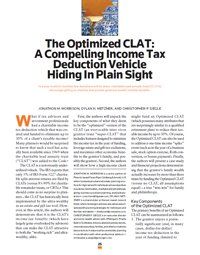After graduating from Duke with a degree in Physics in 1961, Koskinen set out to Yale School of Law (“I decided that people were more interesting than electrons”). Thirty-seven years later — inspired by his years at Duke, keen human interest, and desire to preserve his children’s inheritance — Koskinen set up a charity lead annuity trust to benefit the university. While endowment programs have long sought out generous contributions from donors, Koskinen was ahead of his time in using a CLAT to provide exponential yearly benefits to both donor and institution. Koskinen’s CLAT used the appreciation from his invested stocks to fund athletic scholarships and to build a 4,500-seat, state-of-the-art lacrosse and soccer stadium (that now carries his name) at Duke. These projects helped elevate the university’s sports program to national prominence. Koskinen’s leadership demonstrated the CLAT’s power as one of the most robust estate planning tools available for both philanthropy and generational wealth creation.
Growing up, Koskinen worked summers during high school to help support his family after his father passed away. His own matriculation to Duke was made possible by a scholarship. So when the time came to assign a charitable beneficiary to his CLAT, the university immediately came to mind.
“I had a rare opportunity thanks to scholarships, and I wanted to do whatever I could do to pay that forward and give educational opportunities to kids. In many cases, it’s the difference between attending college or not.” Koskinen’s CLAT paid a fixed annuity to the university for 20 years, endowing dozens of women’s soccer scholarships while also funding the stadium. And after the trust’s 20 year charitable lock-up period , the remaining assets were distributed to his children — tax-free.
Endowment programs are increasingly turning to CLATs because they provide a way to support the institution while also granting big tax benefits to their donors. By setting up a CLAT, donors are able to make a charitable donation and receive an immediate income tax deduction of up to 30% of their adjusted gross income. Koskinen, who arguably knows the tax code better than anyone, asserts his CLAT worked out perfectly and he would choose the same strategy again in today’s economy, “without a doubt,” (as opposed to a gift trust or other trust model).
Favorable IRS rulings and regulations of the past two decades have made the CLAT even more attractive than when Koskinen enacted his. Moreover, an improved variant called the “Optimized CLAT” (or OCLAT) can further maximize benefits to the donor and the university. For example, every $1 million in stocks shifted into a 30-year OCLAT would immediately save the donor 30% of income taxes (an extra $300,000-$500,000 cash preserved in April) and – over the next three decades – deliver approximately $3 million in donations to the university or charity and $5 million tax-free to the donor’s heirs after the charitable lock-up period (assuming an 8% annual return). This philanthropic strategy and wealth creation tool can be repeated each year. Yet despite their clear benefits, CLATs are notoriously underutilized.
Koskinen explains, “People are anxious about what life is going to bring, which is why charitable lead trusts work well within established institutions where the funds are being professionally managed.”
“Nobody can predict what the next 20 years will look like in this country,” he admits. “But the best investment advice has been buy and hold. Ever since the Depression, the economy has done well. Even during the recession of 2007, it was the people who sold when times were tough who I worried about most. There are always uncertainties in the economy, but in America, there’s usually another boom around the corner. Now is a good time to invest – especially with the assurance of a CLAT.”
Knowing his children were taken care of financially through the CLAT allowed Koskinen to focus on public service and passion projects later in his life, freeing him up to act as president of the U.S. Soccer Foundation and Deputy Mayor of the District of Columbia; serve on the Board of Trustees of Duke University; lead the successful effort by Washington to host games in the 1994 World Cup; and start the program that is now on its way to building over 1,000 soccer fields in urban areas around the country. In supporting young people to reach their potential academically, athletically, and societally, John and his wife Pat provide an example of a life well-lived.



